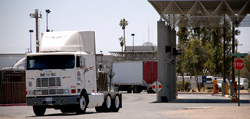Industry-Wide News
Back to Industry-Wide News
Dear friends and customers,
The following is to inform you that the U.S. will ban imports of all goods made in whole or in part from any good from the Xinjiang Uyghur Autonomous Region in China effective June 21. Companies should be finalizing efforts to ensure their supply chains do not include such goods.
President Biden signed into law Dec. 23, 2021 the Uyghur Forced Labor Prevention Act (UFLPA), which effectively deems all goods mined, produced, or manufactured in the XUAR to be produced by forced labor in China. Even companies not importing directly from China may have goods detained if the materials used to produce the imported goods in a second country are tied at any level to XUAR or specific entities or commodities associated with forced labor in China.
Under the UFLPA, imports of goods from the XUAR will be banned unless CBP determines that:
- The importer of record has fully complied with relevant guidance to be provided by CBP, as well as any regulations issued to implement that guidance;
- The importer has completely and substantively responded to all inquiries for information submitted by CBP to ascertain whether the goods were made wholly or in part with forced labor; and
- By clear and convincing evidence, the goods were not made wholly or in part by forced labor.
If a shipment is detained, Importers of Record will have the option to exclude the shipment, meaning the importer will have to export shipment out of the United States, or to request an exception to the rebuttable presumption and will have 30 days to submit complete documentation proving shipment complies with Forced Labor Enforcement Task Force (FLETF) Importer Guidance and that it has a clean supply chain, free of forced labor. CBP’s level of evidence will be high. It will be more controlled and consistent than WRO´s.
Any good from the XUAR that thus overcomes the rebuttable presumption of being made with forced labor will be included in a public list to be issued by CBP 30 days after making such determination.
Importantly, the UFLPA calls for the Task Force to provide guidance to importers with respect to the following.
- Due diligence, effective supply chain tracing, and supply chain management measures to ensure they do not import any goods made with forced labor from mainland China and especially from the XUAR
- The type, nature, and extent of evidence that demonstrates that goods originating in mainland China were not made wholly or in part in the XUAR
- The type, nature, and extent of evidence that demonstrates that goods originating in mainland China, including goods detained or seized pursuant to Section 307, were not made wholly or in part with forced labor
If you have any questions please feel free to contact our offices.
Sincerely,
Estimados amigos y clientes,
Le informamos que EE. UU. prohibirá las importaciones de todos los productos fabricados en su totalidad o en parte a partir de cualquier producto de la Región Autónoma Uyghur de Xinjiang en China a partir del 21 de junio. Las empresas deberían estar finalizando los esfuerzos para garantizar que sus cadenas de suministro no incluyan dichos productos.
El presidente Biden promulgó el 23 de diciembre de 2021 la Ley de Prevención del Trabajo Forzado Uyghur (UFLPA), que efectivamente considera que todos los bienes extraídos, producidos o fabricados en el XUAR se producen mediante trabajo forzado en China. Incluso las empresas que no importan directamente de China pueden tener bienes detenidos si los materiales utilizados para producir los bienes importados en un segundo país están vinculados en cualquier nivel a XUAR o entidades específicas o productos básicos asociados con el trabajo forzado en China.
Según la UFLPA, se prohibirán las importaciones de bienes de la XUAR a menos que CBP determine que:
1. El importador registrado ha cumplido en su totalidad con la orientación pertinente proporcionada por el CBP, así como con las reglamentaciones emitidas para implementar dicha orientación;
2. El importador ha respondido completa y sustancialmente a todas las solicitudes de información presentadas por CBP para determinar si los bienes se fabricaron total o parcialmente con trabajo forzoso; y
3. Mediante pruebas claras y fehacientes, las mercancías no fueron fabricadas total o parcialmente mediante trabajo forzoso.
Si un embarque es retenido, el importador tendrá la opción de excluir el embarque, refiriendo a que se exportará fuera de los Estados Unidos, o solicitar una excepción a la presunción refutable y tendrá 30 días para presentar la documentación completa, comprobando que el embarque cumple con la Guía del Importador de la Administración del Trabajo Forzado (FLETF) y que cuenta con una cadena de suministro libre de trabajo forzado. El nivel de evidencias de CBP será alto. Será más controlado y consistente que WRO´s.
Cualquier bien de la XUAR que así supere la presunción refutable de ser realizado con trabajo forzoso será incluido en una lista pública que será emitida por la CBP 30 días después de hacer tal determinación. Es importante destacar que la UFLPA solicita que el Grupo de trabajo brinde orientación a los importadores con respecto a lo siguiente.
1. Diligencia debida, seguimiento efectivo de la cadena de suministro y medidas de gestión de la cadena de suministro para garantizar que no importen ningún producto fabricado con trabajo forzoso de China continental y especialmente de la XUAR.
2. El tipo, la naturaleza y el alcance de las pruebas que demuestran que las mercancías originarias de China continental no se fabricaron total o parcialmente en la XUAR
3. El tipo, la naturaleza y el alcance de las pruebas que demuestren que los bienes originarios de China continental, incluidos los bienes detenidos o incautados de conformidad con la Sección 307, no se fabricaron total o parcialmente con trabajo forzado.
Siéntanse libres de contactar nuestras oficinas ante cualquier duda.
Atentamente,
Latest News
Border Wait Times



